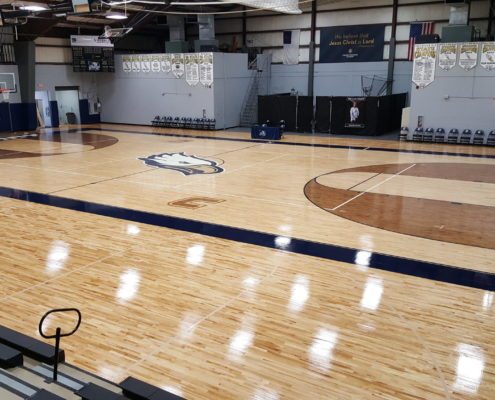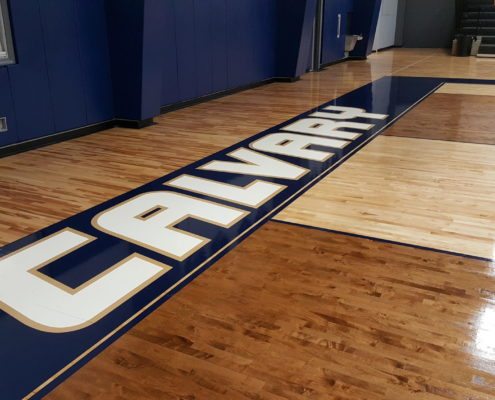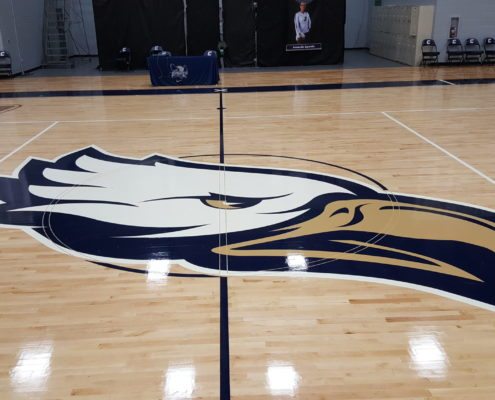Calvary Christian Academy
Location: Fort Lauderdale, FL
Floor Type: Bio-Channel SB
Robbins Dealer: Robbins
Sq. Ft: 12,400
“Visually it’s just beautiful, from the logos and the print and everything it speaks volumes. And for those who are dealing with shin splints and impact injuries, they love the new floor. Our boys’ basketball program won a state championship last year so we obviously have a program of high caliber and now we have the facility that matches it. It’s hard to explain unless you go onto a vinyl floor versus a wood floor. It’s just completely different.”
Project Overview:
Vinyl might be good for siding or records, but not for basketball courts. At Calvary Christian Academy in Fort Lauderdale, they discovered that the hard way. The school, one of South Florida’s largest Christian schools, was forced to throw good money after bad constantly repairing a hazardous vinyl gymnasium floor until parents and administrators decided their students deserved the best – a premium Robbins maple floor installed by Robbins Dealer Impact Sport Surfaces.
“They (the vinyl installer) used the wrong glue to put the floor down and it was bubbling, so at the seams it was ripping and then there would be bubbling underneath and we would have them repair it every year for like 1200 bucks,” says CCA Athletics Director Keith Huisman. “We were just dealing with constant performance issues in terms of it being a trip hazard.”
One bubble was 15 feet long running between the basket and the 3-point line right in the middle of play. The repair involved cutting the floor and reapplying glue. But, as soon as one bubble would be fixed, a new one would pop up.
The 10-year-old floor needed to be replaced before a major injury occurred. The 2017 State Champion CCA Eagles, some of whom were being scouted by colleges and universities nationally, as well as the school’s volleyball players, needed a safe, quality playing surface.
Robbins officials said this scenario is all too common and is a main reason they refuse to install a subpar vinyl flooring product for their customers.
Proven Safety:
There is no comparison between a vinyl and a high-quality maple basketball court. For Robbins, athlete and user safety is of the utmost concern. That’s why Robbins has a dedicated full-time research and product development staff that is committed to maximizing player safety.
“The best thing you can do on a floor system to prevent injuries is make the floor system as uniform as possible, that means every step the individual takes is performing the same,” explains Robbins Maple Product Manager John Puening. “With our wood floor it’s basically going to be one monolithic surface.”
That’s not so with a vinyl floor, according to Puening, who holds a degree in Manufacturing Engineering. For the last two decades Puening has worked at Robbins and done research and development building, designing and testing product samples.
According to Puening, vinyl is manufactured in rolls which are laid upon a concrete surface with adhesive. The rolls are then seamed together. Puening said in artificial athlete testing, there is great variation between the center of a roll versus at the seams – a big safety risk.
In the case of many vinyl floors like the CCA floor, the adhesive failed, leaving the floor prone to bubbling and tearing, which could be catastrophic for athletes.
Robbins floors are designed to be resilient and comfortable. They are tested for force reduction and deflection properties. For instance, a Robbins Bio-Channel SB will have a force reduction, or shock absorption, of about 60 percent, whereas a vinyl floor ranges from 20 percent to 40 percent, at best. Additionally, the deflection capabilities, or how far the floor moves up and down, are far superior on a wood floor.
Vinyl floors are notorious for using closed-cell foam pads for their resilient aspect of the floor, as well. “What happens with closed-cell foam is, if you can imagine like a bubble wrap, once you pop the bubble basically the protection that bubble wrap provides is gone,” Puening explains.
Puening said it’s not unusual for the vinyl floor to become depressed under the basket and in the lane, the more heavily used parts of the floor.
With Robbins Bio-Channel SB, an open-cell foam is used, which is a sponge-like material that bounces back and regains its shape time after time, keeping the wood floor uniform throughout its 40-year life expectancy.
Proven Performance:
While the upfront cost of a wood floor is slightly higher than vinyl, on average $106,000 versus $80,500, the cost over the lifetime makes the wood floor a much better value. A wood floor will last 40 years, whereas a vinyl floor is lucky to make it to the 15-year mark. Considering the maintenance and repair costs, a wood floor averages $131,850 over 40 years, with a vinyl floor coming in at a steep $313,230 over the same time period – nearly 2-and-a-half times the cost!
Annual maintenance on a wood floor includes abrading or lightly sanding the floor, then putting on a coat of finish to make it pop and look brand new. Every ten years, it is recommended to sand down to bare wood, where graphics can be changed up, also.
“You can change the whole personality of the floor with different game lines and colors and logos,” Puening says. “Where a vinyl floor, in order to kind of change it up some, you would have to actually remove it.”
If the vinyl floor is fading, installing a new floor is the only option to fix the problem.
“The biggest thing is a wood floor on that particular job site (CCA) as far as life cycle costs, will be a lot less and the uniformity over time is going to be a lot better for every person that’s on that floor. With a uniform floor, the risk of an injury is going to be less,” Puening details.
Proven Winners:
For CCA, a Robbins wood floor would project a professional, high-quality look, while ensuring player safety. CCA officials received bids for the job and wasted no time in contacting the winning bidder Darin Aarnio, one of the owners at Impact Sport Surfaces. Huisman knew what quality work Aarnio did, as they worked together previously.
“When it comes down to it, it’s people that I trust and Darin is one who whenever I talk to him he’s a straight shooter and I know he’s an expert from the floors he’s done,” Huisman said. “I trust Darin and Darin trusts Robbins, so therefore I trust Robbins.”
Aarnio recommended the Robbins Bio-Channel SB, which meets and exceeds all third party industry standards for safety and performance. Getting rid of the old vinyl and installing the 12,400 square-foot top-of-the-line product was just what CCA needed. The floor was completed in the fall of 2017 and the results were stunning, earning Impact a spot as a Sports Surface of the Year Award Finalist.
“Visually it’s just beautiful,” Huisman says. “From the logos and the print and everything it speaks volumes.”
Huisman says the students love it and it looks, feels – even sounds more like a gym. The cost was roughly the same as the vinyl floor. But most importantly, it’s safer for the athletes.
“For those who are dealing with shin splints and impact injuries, they love it,” Huisman said. “Our boys’ basketball program won a state championship last year so we obviously have a program of high caliber and now we have the facility that matches it. It’s hard to explain unless you go onto a vinyl floor versus a wood floor. It’s just completely different.”



